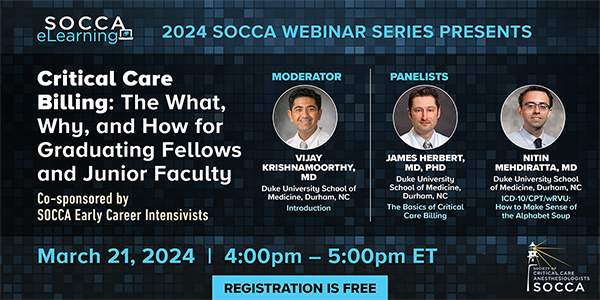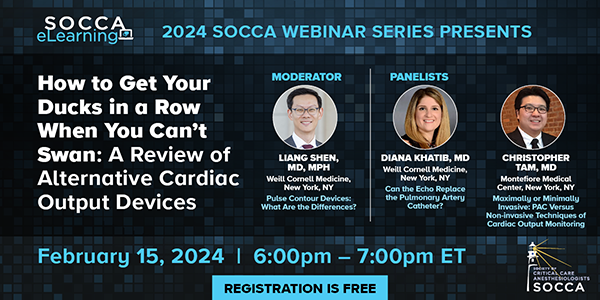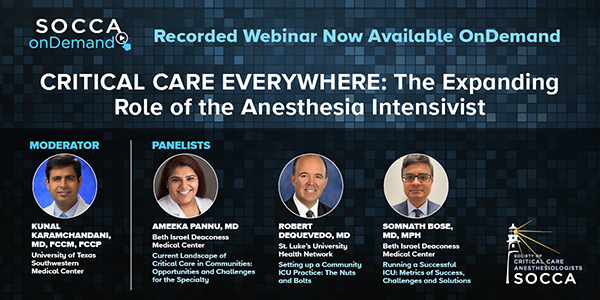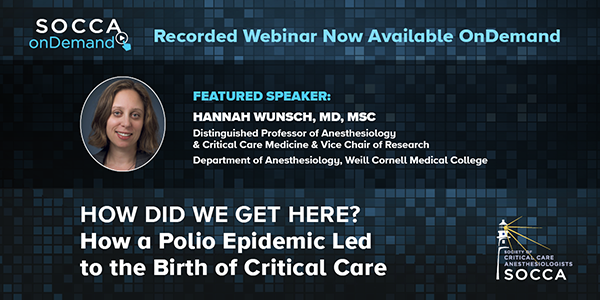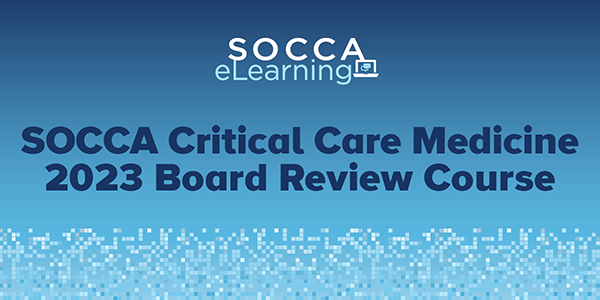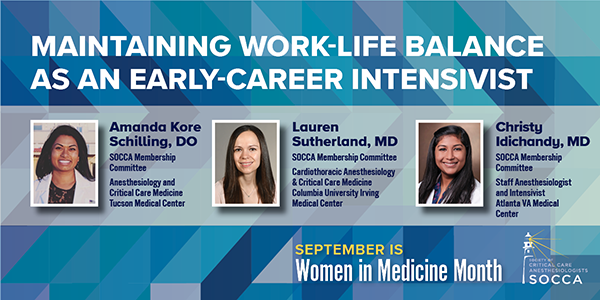The field of transplant surgery, with its roots traced back to the pioneering work of Sushruta in 600 BC, has undergone a remarkable evolution. On behalf of the SOCCA-SATA Work Group, this review focuses on transplant anesthesiology, a field of medicine that has played a pivotal role in transforming transplantation into a life-extending therapy for patients with end-organ failure. Advances in multidisciplinary collaboration and research have improved surgical success and patient outcomes.
Continue Reading…
As the 2024 fellowship match cycle draws to a close, critical care leaders and stakeholders face a concerning reality. Data from this year’s match once again highlight trends that mirror the previous cycle, with 36% of anesthesiology critical care fellowship positions going unfilled. This persistent gap raises an urgent question: does this pattern signal a sustained decline in interest in our subspecialty?
Continue Reading…
Substantial research has confirmed a critical link between perioperative glucose levels and perioperative complications including death. Hyperglycemia has been found to be the main culprit and affects 20-40% of postoperative patients and up to 80% of patients having cardiac surgery, though hypoglycemia is equally dangerous. Regardless of a preexisting diagnosis of diabetes mellitus (DM), higher glucose is an independent predictor of mortality for patients having cardiac surgery.
Continue Reading…
In-flight medical emergencies (IMEs) are estimated to occur in 1 of every 604 flights; given the tremendous volume of global air travel, 260 and 1420 IMEs may occur daily.1 Invariably, these events take place in a complex setting characterized by limited information and equipment. Many physicians have little personal experience responding to in-flight crises, and even seasoned anesthesiologist-intensivists will likely find these events challenging and stressful. This article briefly overviews clinical, logistical, and legal considerations relevant to managing in-flight medical emergencies.
Continue Reading…
Global prevalence for obesity and type 2 diabetes are continuing to rise, with special concerns for the very high prevalence of obesity (>25% of adults) and Type 2 diabetes (>13% of adults) in several regions of the Americas, Middle East and amongst Pacific Island communities.
Continue Reading…
In 2023, the American Academy of Pediatrics, Child Neurology Society, Society for Critical Care Medicine and the American Academy of Neurology released an updated set of guidelines for Brain Death/Death by Neurologic Criteria (BD/DNC). These were the first guidelines to provide recommendations for both adult and pediatric patients.
Continue Reading…
Over the past few decades, critical care medicine has rapidly evolved into the cornerstone of modern healthcare. The recent pandemic made us aware of the need for critical care specialists. The demand for intensive care services has continued to rise in response to the increasing complexity and acuity of both medical and surgical conditions.
Continue Reading…
Coaching and mentoring are valuable tools in a physician’s professional development. They serve similar goals but have unique roles and boundaries. A mentor tells you how, but a coach asks you why.
Continue Reading…
Introduction: Neuro-critical care constitutes a demanding, high-alert setting that requires expeditious decision-making by critical care teams in response to patient health status. The resource-intensive nature of neuro-critical care settings results in a substantial financial burden. As of 2016, the Centers for Disease Control and Prevention (CDC) reported an annual national healthcare spending cost of $40.6 […]
Continue Reading…
In 2022, the medical community was introduced to the capabilities of ChatGPT – a popular large language model (LLM) that performed exceptionally well in medical problem solving, scoring above 85% on both USMLE Step 1 and Step 2. ChatGPT is a chatbot composed of an advanced language model from the family of Generative Pretrained Transformer (GPT) models designed by OpenAI (San Francisco, California) in 2018.
Continue Reading…
The first public demonstration of an ether anesthetic in 1846 marked a turning point in our ability to provide safe and effective medical care. It birthed the specialty of anesthesiology as we know it today.
Continue Reading…
by George Istafanos, DO, Michael Salomon, MD, and Piyush Mathur, MD, FASA, FCCM, FAMIA
The integration of Artificial Intelligence (AI) in various industries has progressed rapidly in medicine, particularly in critical care. The number of articles published regarding AI in critical care medicine tripled from 2018 to 2020.1 From the use of AI to predict the likelihood of sepsis, intensive care unit (ICU) mortality, and length of stay, many predictive models have been developed for use in the ICU setting. It is essential for the modern intensivist to understand the basics of how AI works and how to analyze studies based on AI. This article aims to fulfill these two goals and provide a foundation of knowledge that can be used to implement AI in your practice.
Continue Reading…
by Avneep Aggarwal, MD, Piyush Mathur, MD, FCCM, FASA, FAMIA, and Ashish K. Khanna, MD, MS, FCCP, FCCM, FASA
Utility of Predictive Analytics in Critical Care
Identifying the underlying cause of clinical deterioration in postoperative patients in the intensive care unit (ICU) can be difficult.
Continue Reading…
by Beth M. Teegarden, MD, FASA, Ernesto Lopez Valencia, MD, PhD, and Lindsay D. Nowak, MD
It is an exciting time to pursue an anesthesiology fellowship in critical care medicine (CCM). As we emerge from COVID-19, there is a renewed energy for scientific investigations, making connections, and integrating wellness strategies to mitigate burnout. Technological advances in hemodynamic monitoring, the use of artificial intelligence or data analytics, and application of novel biomarkers are all captivating areas of investigation. Moreover, the integration of bedside point-of-care ultrasound (POCUS) continues to grow and offers opportunities to be at the forefront of clinical care. If you’ve had a chance to attend recent regional or national anesthesiology or CCM meetings, you have likely noticed expanded opportunities to network and for mentorship at all stages of training. There has been a palpable energy around these connections and a desire to collaborate. It has been a real pleasure to connect with former colleagues, meet new friends and learn from a diverse collection of experts in the field.
Continue Reading…
by Amber N. Campbell, MD, MS and Christopher Chung, MS3-UTHealth Houston
Introduction
This case report describes a young man who developed a tracheal-esophageal fistula (TEF) from endotracheal intubation with prolonged elevated cuff pressure after a traumatic fall. This case report describes the intra-operative management of profound hypoxia, shedding light on crucial pre-operative indicators that could serve as vital cues to prevent the occurrence of this potentially serious complication.
Continue Reading…
by Jordan M. Stefko, MD, Michael Dougherty, DO, Danielle L Holland, MD, Bridget Hughes, PA-C, and Ron Leong, MD
Introduction:
Acute right ventricular failure (RVF) due to post-left ventricular assist device (LVAD) placement is challenging to treat with the management often limited to placement of either surgical or percutaneous mechanical circulatory devices. The Protek Duo® (LivaNova) is a percutaneous right ventricular support device (RVAD), which due to its relative ease of placement, has been a breakthrough in the management of post-LVAD implantation acute RVF. 1
Cardiac perforation from placement of a Protek Duo cannula is a rare but potentially lethal complication. This case is the first to describe a patient who developed cardiac tamponade from a Protek Duo cannula perforation of the right ventricle. The report discusses preoperative and intraoperative management of this condition and relevant transesophageal echocardiography (TEE) imaging that aided in the diagnosis and surgical repair of the perforation.
Continue Reading…
by Erin Hennessey, MD, MEHP and Babar Fiza, MD
For the second year in a row, we have witnessed a decline in the number of applicants interested in anesthesiology critical care fellowships. The gap between the number of positions available and the number of rank lists submitted continues to increase, with only 0.65 applicants per position offered in the 2023 match cycle. This year an alarming 39% of positions were left unfilled post-match. These distressing statistics demand a serious reflection on the challenges we face and the necessary steps to ensure the future of our subspecialty. As we move forward after inspiring stories of anesthesiology intensivists as healthcare heroes and leaders of the COVID-19 pandemic, we must reflect on the past, current state, and future of our subspecialty. While it may be tempting to attribute the current lack of interest to a robust job market and attractive pay, perhaps an introspective approach and reflection are needed to understand other factors that contribute to our specialty’s diminishing appeal to today’s trainees?
Continue Reading…
by Madiha Syed, MD and Luai Zakaria, MD
In recent years, the critical care community has debated the benefits of vitamin C in septic shock. Vitamin C is thought to have antioxidant effects that attenuate tissue injury mediated by inflammation1. A controversial retrospective analysis to evaluate the efficacy of vitamin C demonstrated a major reduction in mortality, AKI, and vasopressor duration2. This fascinating result led to several prospective trials and meta-analyses3, 4. Most recently, a large trial showed that patients in intensive care who received vitamin C therapy had a higher risk of death or persistent organ dysfunction5. With this result, the community has explored alternative therapies to manage septic shock. Vitamin B12, hydroxocobalamin, may be the next in line for evaluation, scrutiny, and debate.
Continue Reading…
by Rafał Kopańczyk, DO and Hannah Wunsch, MD, MSc
Financial Disclosures: Dr. Wunsch has research funding from the U.S. Department of Defense (DOD), U.S. National Institutes of Health (NIH), and Canadian Institutes of Health Research (CIHR).
Conflicts of Interest: Dr. Wunsch is an author of the upcoming book, The Autumn Ghost: How the Battle Against a Polio Epidemic Revolutionized Modern Medical Care (Greystone Books, May, 2023).
This year marks the 70th anniversary of the opening of the first modern intensive care unit (ICU). Located in The Municipal Hospital of Copenhagen, the unit possessed many components that are recognized as integral to critical care today: a dedicated area set aside for the sickest patients, 24/7 coverage by specialized staff, frequent monitoring of vital signs, invasive mechanical ventilation, and blood gas analysis [1]. Although situated across the ocean, there was an American connection; the unit was opened by a trailblazing anesthesiologist, Bjørn Ibsen, who had trained for a year at the Massachusetts General Hospital. Ibsen’s pioneering work was born out of his generation’s health emergency, a polio epidemic [2]. Not unlike today’s struggle with the coronavirus disease 2019 (COVID-19), Ibsen also faced the deadly respiratory sequela of a viral infection. By application of knowledge and experience gained during his anesthesia training in Boston and Copenhagen, he was able to diagnose and treat hypercapnic respiratory failure. His novel intervention and subsequent work in establishing the first ICU saved countless lives and changed the face of medicine forever. As our critical care community recovers from the arduous pandemic response, appreciation of the connections with our predecessors may enable us to better cope with stresses we have experienced. Such origin stories may help us to feel proud of our identity, gain perspective on the struggles we encountered, and feel invigorated for what is to come. This is the story of a visionary who laid the kindling for the field of critical care medicine.
Continue Reading…
by Ioannis Angelidis, MD, MSPH and Emily Naoum, MD
Severe maternal morbidity in the United States has increased 200% from 1993-2014, with maternal mortality rising to a rate most recently estimated as 17.4:100,000 making this a major public health issue.1 Half of these deaths occurred in the beginning of the postpartum period and 60% of the total deaths were classified as preventable.1 This rate is subject to disparities with the incidence of severe maternal morbidity being higher in every racial and ethnic minority category compared to non-Hispanic white women.2 The most common etiologies of maternal mortality in the United States is cardiac disease, followed by hemorrhage, and then sepsis.3 These high-risk patients would benefit from a dedicated obstetric intensive care unit (OB ICU). Between 1-3% of pregnancies require an ICU admission based on studies in high income countries.4 This number is likely to rise with the increase in maternal morbidity and should prompt a consideration of the best way to deliver critical care to this special population.
Continue Reading…
by Tyler Beattie, MD, Douglas R. Adams, MD, and Gozde Demiralp, MD
Introduction:
Neostigmine is a reversible acetylcholinesterase inhibitor that functions as a parasympathomimetic drug that has an on-label use for reversing neuromuscular paralytics. In addition, it is indicated in the off-label treatment of acute colonic pseudo-obstruction and critical illness associated ileus. Neostigmine is associated with side effects such as bradycardia, asystole, and pulmonary side effects including bronchospasm and increased pulmonary secretions1,2. There are no studies or case reports describing the use of neostigmine in lung transplant patients. Presented is the case of a 68-year-old comorbid male who underwent bilateral lung transplantation with a post operative course complicated by ileus that was treated with a series of IV neostigmine boluses resulting in increased pulmonary secretions and oxygen requirements.
Continue Reading…
by Hemanckur Makker, MD and Matthew Jeranek, MD
Point-of-care ultrasound (POCUS) has become an integral part of the anesthesiologist and intensivist toolbox for the diagnosis and management of various disease states especially as ultrasound systems become more ubiquitous in our hospitals and increase in portability and ease of use1. This has been emphasized by the ABA in adding the application and interpretation of POCUS cardiac, lung, and abdominal imaging to the Applied Exam2. Working with residents and fellows, I often wonder about the most efficient and effective way to teach these skills in a busy clinical setting. How do we best integrate this into the trainee curriculum? How many exams are necessary for a trainee to become competent (independent)? Should residents strive for some sort of certification?
Continue Reading…
by Vinodkumar Singh, MD, Ayesha Bryant, MD, MSPH, Meghana Muppuri, MBBS, and Arnav Muppuri
Artificial intelligence (AI) is a revolutionary inclusion to current medical practice, particularly in the field of Critical Care medicine. The actualization of AI is empowered with the intellectual acumen to analyze and generate vastly complex data, as well as integrate from experience, based on recognition of formed patterns. This is achieved through machine learning and perception, compounded by natural language processing, and automated simple repetitive tasks or exposure. These are attributes or skills born from the innovative integration of human intelligence and computer systems. Thus, allowing for a multitude of decision-making and task-executing functions. Critical Care widely encompasses an intricate and detail-oriented multidisciplinary approach in diagnosing diseases and analyzing their progression with simultaneous treatment interventions. While the established conventional approach to medical management has proven to be undoubtedly reliable, it is also unremarkably challenging and time-consuming to medical professionals in the face of disease progression and overwhelming workload. The field of Critical Care establishes multiple landscapes and opportunities in which AI is a transformative asset to researchers and Critical Care physicians alike.
Continue Reading…
by Anoop Chhina, MD, William Peruzzi, MD, and John Reveille, MD
Ankylosing Spondylitis (AS) is an inflammatory rheumatic disease that primarily affects the spine, although other joints and organs can become involved. AS and its parent disease, Axial Spondyloarthritis, are not rare, and affect at least 2 million and 5.9 million adults in the United States alone, respectively (1,2,3).
Continue Reading…
by Erin Hennessey, MD
Introduction
Anesthesia Critical Care Medicine (ACCM) is the oldest ACGME board-certified subspecialty within Anesthesiology and has seen tremendous growth over the past decade. In an effort to organize, streamline, and create a fair and equal process for fellowship recruitment, ACCM fellowship programs have participated in the SFMatch process since 2014. Over the past nine years we have increased the number of fellowship programs offering positions in the match by 35% and increased the number of positions by 58%. Despite the expansion at the programmatic level, the interest in the field has yet to catch up to the need, and we remain with unfilled positions throughout the country.
Continue Reading…
by Aalok Kacha, MD, PhD, FASA
A milestone in transplantation was recently announced by United Network for Organ Sharing (UNOS) commemorating the completion of over one million transplants in the United States.1 This achievement reflects a steady increase in annual transplant volumes with over 400,000 transplant recipients alive today. It is commonly understood that anesthesiologists are instrumental in peri-operative care of both organ donors and organ recipients. Less widely recognized, but equally important, is the involvement of anesthesiologists in patient selection, risk assessment, coordination of care for pre-operative optimization, and post-operative care. This includes the provision of critical care services for potential transplant candidates with end-stage organ failure, care of high acuity post-operative patients, management of post-transplant complications, and supportive care for organ donors.2
Continue Reading…
by Allison Dalton, MD
Even prior to curricular changes necessitated by the COVID-19 pandemic, adult medical education had been evolving from a primarily in-person lecture-based structure to a more interactive and reflective approach to learning.
Continue Reading…
by Mada F. Helou, MD and Angela Johnson, M.D.
Despite the fact that incoming senior residents have had experience in the intensive care unit (ICU) as interns, they may have insufficient skills for advanced level care processing. In order to address this gap we initiated a three day “ICU Boot Camp,” delivered at the end of PGY-2 year. The purpose of the curriculum is to equip junior residents with the foundational knowledge and skills required to transition efficiently into the senior resident role. Additionally, this training increases resident confidence and sets expectations for faculty regarding the starting performance level of the newly minted senior. The curriculum covers commonly encountered clinical scenarios, diagnoses, treatments, monitors and devices in a systematic manner.
Continue Reading…
by Christopher Webb, MD and Paul Weyker, MD
One of the largest challenges faced by leaders in healthcare during the Covid-19 pandemic was making difficult decisions in the face of ambiguity. This parallels what is taught in business school where future leaders are taught how to make management and financial decisions with limited information.
Continue Reading…
by Michelle Daryanani, DO and Navitha Ramesh, MD, FCCP
With the holiday season upon us, in the US and globally, ICUs (Intensive Care Units) are still struggling with the deadly COVID-19 pandemic. For the first time in our history, hospital systems are forced to scramble to allocate scarce resources such as nursing, respiratory therapists, ICU beds, oxygenation, and drug treatments that lack adequate amount of literature support.
Continue Reading…
by Craig Jabaley, MD, Kimberly Rengel, MD, Santiago J. Miyara, MD, MSCE, and Jamie Privratsky, MD, PhD
Peter Safar, the creator of the first intensive care unit (ICU) in the United States, father of cardiopulmonary resuscitation, pioneer of the modern ambulance design, and three-time nominee for the Nobel Prize, repeatedly delivered a very simple message: physician-scientists are in danger of extinction.1
Continue Reading…
by Shahla Siddiqui, MD and James M. Haering, MD
Searches are often conducted within academic departments to find suitable candidates for leadership succession. This is usually done either when a vacancy emerges, following a retirement or when a new role is created. Internal searches are carried out to offer inclusion to emerging talent and add diversity to the pool of academics already holding administrative roles. Finding a good fit for a leadership role is an inexact science.
Continue Reading…
by Margo Short, MD
Out of hospital cardiac arrest is a highly morbid and clinically challenging public health issue.
Continue Reading…
by Hannah Viroslav, MD and Sarah Khorsand, MD
Imposter syndrome is the internal struggle to trust our knowledge and capability, and it follows many of us through each facet of training and career. I first experienced it in medical school. Time and experience is a good antidote, but the real remedy is mimicry; “fake it until you make it.”
Continue Reading…
by Ryan J Fink, MD and Chris Varani, MD
We previously reviewed data related to the risk of healthcare workers contracting COVID-19 in December of 2020 (Interchange:31[3]). One study of front-line healthcare workers demonstrated a 4% positive COVID-19 testing rate compared to just 0.33% for the general population. In a survey study of 105 anesthesiologists and intensivists at a New York City hospital, 58% reported a workplace exposure (mostly related to airway management), 26% of those reported COVID-19-like symptoms after that exposure, but only 12% of providers tested were found to be positive for antibodies.
Continue Reading…
by Louanne M. Carabini, MD, MA, FASA
According to Oxford Languages, to “practice” means to pursue a professional activity or exercise a skill regularly and routinely to improve proficiency. I am an anesthesiologist who “practices” critical care medicine and the residency program director for more than seventy-six residents in a large training program. I am also a mother, a wife, sister, and daughter; and I have to practice being human every day. We are all human, and we deserve more competence and proficiency as we interact together. Often, my biggest challenge that demands practice for proficiency is the transition from work to life.
Continue Reading…
by Shahla Siddiqui, MBBS, MSc (Medical ethics), FCCM
To at least some degree, we all entered medicine for altruistic reasons: helping others, finding meaning in providing comfort and care, and saving lives. We in critical care are especially driven to offer management of life-threatening disease states as well as solace and comfort to critically ill patients. This aspect has been highlighted in striking detail during the pandemic where, despite the grueling physical demands of working in ICUs during this time, the discomfort of PPE, and the trauma of watching so many people die and so many families suffer, we still find joy and reward in the lives we save and the families whose lives we touch by our compassion.
Continue Reading…
by Shahla Siddiqui, MBBS, MSc (Medical ethics), FCCM
COVID-19 has drastically changed how end-of-life care is practiced in the intensive care unit (ICU). Safety concerns for society limits family visitation but is contrary to patient and family-oriented care. This article provides an ethical analysis of the pros and cons of having family members present at the death of a critically ill patient with COVID-19 and provides a framework that can be used in future surges.
Continue Reading…
by Zyad J. Carr, MD, FASA and Andrea Farela, MD
Postoperative pulmonary complications have been recognized and appreciated by physicians since symptoms of pneumonia were first described by Hippocrates, the father of western medicine, in 460 BC. Despite our extensive familiarity with this pervasive ailment, pneumonia remains the third-most common postoperative complication with an overall incidence of 1.3-1.8%.
Continue Reading…
by David Jury, MD, MS, Madiha Syed, MD, and Silvia Perez- Protto, MD, MS, FCCM
Advance care planning (ACP) is a process that supports adults at any age or stage of health in understanding and sharing their values, goals, and preferences regarding future medical care. The goal of ACP is to help ensure that people receive medical care that is consistent with their preferences during serious and chronic illness. At the Cleveland Clinic, we operationally defined ACP as having two elements: documentation of the surrogate decision-maker in the electronic medical record (EMR) for all adult patients and goals of care discussion documentation for seriously ill patients. Ideally, this conversation between a seriously ill patient with a chronic condition and their primary provider would happen long before the moment of a critical illness crisis.
Continue Reading…
by Zyad J. Carr, M.D., FASA1
Particularly challenging in the chronically hospitalized, the immunocompromised, and those with cystic fibrosis, P. aeruginosa has found a niche in intensive care units around the world. P. aeruginosa is a very common, encapsulated, gram-negative rod that has been recognized for its highly evolved antibiotic resistance.
Continue Reading…
by Dustin Rumpel, MD, Piyush Mathur, MD, FCCM, and Ashish K. Khanna MD, FCCP, FCCM
Among its many impacts, COVID-19 has spawned a plethora of early data and literature. That which is not high-quality may hinder progress toward our understanding of the disease. Critical care and, more broadly, perioperative medicine are clinical arenas that generate massive volumes of data. As we routinely care for patients with COVID-19 in those settings, these data hold promise to further our understanding of the disease.
Continue Reading…
by Craig S. Jabaley, MD
Media attention concerning the outbreak of a novel coronavirus in December of 2019 has steadily increased over preceding weeks, and at the time of writing there is early evidence of community spread in the United States. The World Health Organization (WHO) has declared the coronavirus disease 2019 (COVID-2019) outbreak to be a Public Health Emergency of International Concern, and significant efforts are underway to better understand the disease’s clinical features, transmissibility, and potential treatment options.
Continue Reading…
by Zyad J. Carr, MD, FASA
Worldwide, candidiasis remains the most the important and common fungal infection with crude and attributable mortality rates of 42% and 27%, respectively. There has been a recent deluge of drug-resistant Candida auris (C. auris) infections in intensive care units (ICUs) worldwide. In the United States alone, C. auris has led to hundreds of deaths in the past three years largely concentrated in Illinois, New York and New Jersey.
Continue Reading…
by Peggy A. White, M.D.
The restriction of trainee work hours in 2006 transformed post-graduate medical education. While intended to promote work-life balance and wellness, the undesired consequence was limitation of experiential clinical learning opportunities. Simulation Based Medical Education (SBME) has helped fill this gap by providing an opportunity for deliberate practice with immediate feedback, enhancing acquisition of medical knowledge and skills.
Continue Reading…
by Mark E. Caridi-Scheible, MD
The aerospace industry is rightly recognized as a model for the utility of high-fidelity simulation, and the medical education community has sought to apply and extend this experience. However, a staggering amount of research, engineering, and resources underlies the success of aerospace simulation, which is likely underappreciated by physicians.
Continue Reading…
by Shahla Siddiqui, MBBS, D. ABA, MSc (Medical ethics)
Since the first organ transplant from a brain-dead donor performed in 1963 by a Belgian surgeon, the topic of organ donation and brain-dead donors has often been a moral and ethical impasse amongst the public as well as physicians. Intensivists, along with Neurologists, have become the primary referring physicians for these donations.
Continue Reading…
by Alison Dalton, MD
Subramaniam B, Shankar P, Shaefi S, et al. Effect of intravenous acetaminophen vs placebo combined with propofol or dexmedetomidine on postoperative delirium among older patients following cardiac surgery: the DEXACET randomized clinical trial.
Continue Reading…
by C. Patrick Henson, DO
As influenza season begins in the United States, we should reflect on the nature of the virus, pathological presentation and treatment considerations. Multiple types of influenza exist, with type A accounting for the most severe manifestations in humans and responsible for the major pandemic outbreaks, notably in 1918, 1957, 1968, and 2009. Types B and C also infect humans but result in a more typical seasonal infection.
Continue Reading…
by Christina Boncyk, MD and C. Patrick Henson, DO
Chronic pain syndromes are a persistent problem in the United States, with conservative estimates suggesting a cost $560 to $635 billion dollars annually. Chronic pain following intensive care unit (ICU) survival is difficult to quantify, as patient populations vary across hospital centers and within different ICU settings; however, current evidence demonstrates that anywhere from 12-60% of patients remain affected by chronic pain at 6-months to a year following ICU admission, which contributes to a significant portion of diagnoses nationally.
Continue Reading…
by German Echeverry, M.D.
Chimeric Antigen Receptor (CAR) T cell therapy is a promising novel cancer treatment modality recently approved by the Food and Drug Administration for relapsed/refractory B cell liquid tumors. Though its use is currently limited to a few designated centers across the US, if this line of therapy continues to deliver on the hype and new indications continue to arise as expected, it is likely that in the coming years it will be coming to a hospital (and an ICU) near you.
Continue Reading…
by Nicholas C. Zimick, MD, MS
“Part of this complete breakfast.” This is the closing line of nearly every breakfast food commercial since at least the mid-1980s. The final scene universally depicts two mainstays: the product, and a cup of orange juice. In popular culture, citrus fruits are crucial to balanced nutrition and provide essential vitamin C. Colloquially, this nutrient is well known to stave off scurvy; but, medically, it has far more powerful potential as a tool to combat the sequelae of infection.
Continue Reading…
by Rhea Ittoop, MD MPH
Is Vitamin C (ascorbic acid) the new and improved answer to decreasing sepsis-related mortality? It’s unclear. Up until this point, ascorbic acid has been studied in small cohorts of mostly cancer or burn patients. Studies in these populations have had variable results, some showing no difference in outcomes and others displaying impressive benefits.
Continue Reading…






